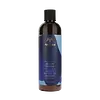What's inside
What's inside
 Key Ingredients
Key Ingredients

 Benefits
Benefits

 Concerns
Concerns

 Ingredients Side-by-side
Ingredients Side-by-side

Water
Skin ConditioningLauramidopropyl Hydroxysultaine
CleansingSodium Cocoyl Isethionate
CleansingCocamide Mipa
EmulsifyingBetaine
HumectantRicinus Communis Seed Oil
MaskingSodium Isethionate
CleansingCetearyl Alcohol
EmollientSodium Chloride
MaskingPiroctone Olamine
PreservativeCeramide NP
Skin ConditioningCeramide EOP
Skin ConditioningCeramide AP
Skin ConditioningPhytosphingosine
Skin ConditioningZanthoxylum Bungeanum Pericarp Extract
Skin ConditioningPhytosterols
Skin ConditioningHydroxypropyl Bislauramide Mea
EmollientHydroxypropyl Bisstearamide Mea
Skin ConditioningMentha Piperita Oil
MaskingMelaleuca Alternifolia Leaf Oil
AntioxidantMenthol
MaskingOlea Europaea Fruit Oil
MaskingPolyglyceryl-10 Laurate
Skin ConditioningGlycol Stearate
EmollientGlyceryl Stearate
EmollientSodium Lauroyl Lactylate
EmulsifyingSodium Cocoyl Glutamate
CleansingCoconut Acid
CleansingGlycerin
HumectantPolyquaternium-7
Stearic Acid
CleansingTrisodium Dicarboxymethyl Alaninate
Hydroxypropyl Cyclodextrin
MaskingCaprylyl Glycol
EmollientEthylhexylglycerin
Skin ConditioningSodium Benzoate
MaskingPotassium Sorbate
PreservativeCitric Acid
BufferingLimonene
PerfumingWater, Lauramidopropyl Hydroxysultaine, Sodium Cocoyl Isethionate, Cocamide Mipa, Betaine, Ricinus Communis Seed Oil, Sodium Isethionate, Cetearyl Alcohol, Sodium Chloride, Piroctone Olamine, Ceramide NP, Ceramide EOP, Ceramide AP, Phytosphingosine, Zanthoxylum Bungeanum Pericarp Extract, Phytosterols, Hydroxypropyl Bislauramide Mea, Hydroxypropyl Bisstearamide Mea, Mentha Piperita Oil, Melaleuca Alternifolia Leaf Oil, Menthol, Olea Europaea Fruit Oil, Polyglyceryl-10 Laurate, Glycol Stearate, Glyceryl Stearate, Sodium Lauroyl Lactylate, Sodium Cocoyl Glutamate, Coconut Acid, Glycerin, Polyquaternium-7, Stearic Acid, Trisodium Dicarboxymethyl Alaninate, Hydroxypropyl Cyclodextrin, Caprylyl Glycol, Ethylhexylglycerin, Sodium Benzoate, Potassium Sorbate, Citric Acid, Limonene
Water
Skin ConditioningSodium C14-16 Olefin Sulfonate
CleansingCocamidopropyl Betaine
CleansingPolyquaternium-7
Cocamide Mipa
EmulsifyingGlycol Stearate
EmollientPolyquaternium-10
Panthenol
Skin ConditioningPropylene Glycol
HumectantMentha Piperita Oil
MaskingRosmarinus Officinalis Leaf Oil
MaskingDisodium EDTA
Phytantriol
HumectantOrbignya Oleifera Seed Oil
EmollientZingiber Officinale Root Oil
MaskingCocos Nucifera Oil
MaskingEquisetum Arvense Extract
AstringentLawsonia Inermis Extract
AntimicrobialRosmarinus Officinalis Extract
AntimicrobialAnthemis Nobilis Flower Extract
MaskingSymphytum Officinale Callus Culture Extract
Skin ConditioningHumulus Lupulus Extract
AntimicrobialUrtica Dioica Extract
AstringentHoney
HumectantBiotin
AntiseborrhoeicRicinus Communis Seed Oil
MaskingPhenoxyethanol
PreservativeBenzoic Acid
MaskingEthylhexylglycerin
Skin ConditioningGlycereth-2 Cocoate
EmulsifyingParfum
MaskingWater, Sodium C14-16 Olefin Sulfonate, Cocamidopropyl Betaine, Polyquaternium-7, Cocamide Mipa, Glycol Stearate, Polyquaternium-10, Panthenol, Propylene Glycol, Mentha Piperita Oil, Rosmarinus Officinalis Leaf Oil, Disodium EDTA, Phytantriol, Orbignya Oleifera Seed Oil, Zingiber Officinale Root Oil, Cocos Nucifera Oil, Equisetum Arvense Extract, Lawsonia Inermis Extract, Rosmarinus Officinalis Extract, Anthemis Nobilis Flower Extract, Symphytum Officinale Callus Culture Extract, Humulus Lupulus Extract, Urtica Dioica Extract, Honey, Biotin, Ricinus Communis Seed Oil, Phenoxyethanol, Benzoic Acid, Ethylhexylglycerin, Glycereth-2 Cocoate, Parfum
 Reviews
Reviews

Ingredients Explained
These ingredients are found in both products.
Ingredients higher up in an ingredient list are typically present in a larger amount.
We don't have a description for Cocamide Mipa yet.
Ethylhexylglycerin (we can't pronounce this either) is commonly used as a preservative and skin softener. It is derived from glyceryl.
You might see Ethylhexylglycerin often paired with other preservatives such as phenoxyethanol. Ethylhexylglycerin has been found to increase the effectiveness of these other preservatives.
Glycol Stearate comes from stearic acid and ethylene glycol.
It is a creamy wax used to stabilize ingredients as an emulsifier. Glycol stearate also contains emollient properties. Emollients sit on top of the skin to prevent moisture from escaping.
This ingredient may not be Malassezia folliculitis, or fungal-acne safe.
Learn more about Glycol StearateMentha Piperita Oil is the volatile oil obtained from the whole plant of the Peppermint plant.
It can be used to add a fresh scent to products.
Peppermint oil may cause skin sensitivity and redness due to its menthol content. Menthol also has a cooling effect (like your toothpaste).
Learn more about Mentha Piperita OilPolyquaternium-7 is a light to clear colored liquid. It is commonly found in haircare products for its film-forming and anti-static properties.
According to a manufacturer, it is a non-paraben and specially developed for negatively charged surfactant systems. This makes it a great hairstyle holder and helps to improve wet hair detangling without adding buildup.
Ricinus Communis Seed Oil is the INCI name for castor oil.
Castor Oil helps moisturize the skin. It is rich in a fatty acid called ricinoleic acid. This fatty acid helps prevent moisture loss on the skin. This helps keep your skin soft and hydrated. Ricinoleic acid also has anti-inflammatory and pain reducing properties.
Besides hydrating the skin, castor oil is also used to hydrate hair. By keeping the hair shaft moisturized, breakage is decreased. More studies are needed to show castor oil's effective on stimulating hair growth.
Castor oil is created by cold-pressing castor seeds and then purifying the oil with heat. It was used in Ancient Egypt as fuel in lamps and to help treat eye irritation.
The term 'fragrance' is not regulated in many countries. In many cases, it is up to the brand to define this term. For instance, many brands choose to label themselves as "fragrance-free" because they are not using synthetic fragrances. However, their products may still contain ingredients such as essential oils that are considered a fragrance.
Learn more about Ricinus Communis Seed OilWater. It's the most common cosmetic ingredient of all. You'll usually see it at the top of ingredient lists, meaning that it makes up the largest part of the product.
So why is it so popular? Water most often acts as a solvent - this means that it helps dissolve other ingredients into the formulation.
You'll also recognize water as that liquid we all need to stay alive. If you see this, drink a glass of water. Stay hydrated!
Learn more about Water